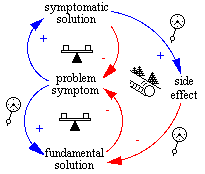
How many times have you noticed that you seem to solve the same problem over and over. When the problem arises you address it, then some time later, maybe a day, a week, or a month later the same problem arises again. This situation is quite often the result of a Shifting the Burden structure.
A Shifting the Burden structure is composed of two balancing loops and a reinforcing loop. It is a very annoying structure because the two balancing loops act as a single reinforcing loop migrating the situation in the same direction as the reinforcing loop. Both structures support the movement of the system in a direction generally other than the one desired.

In the above diagram a problem symptom is
perceived with multiple possible courses of action. One course
of action, the symptomatic solution has an apparent
time frame advantage over the fundamental solution
because of other associated delay. As a result the problem
symptom influences the application of the symptomatic
solution. Application of the symptomatic solution
reduces the problem symptom which dissolves the
perceived necessity of pursuing the fundamental solution.
A failure to implement the fundamental solution
ensures that the problem symptom will return.
Let's face it, band aids on cut knees don't keep one from falling
of bicycles.
As if this wasn't annoying enough, implementation of the symptomatic
solution often, in time, influences the development of
unintended side effects, which are often further
preclude employing the fundamental solution. The interactions
between the problem symptom, symptomatic
solution, side effect, and fundamental
solution form a viscous reinforcing loop which make the
real source of the problem, in time, even more difficult to resolve.